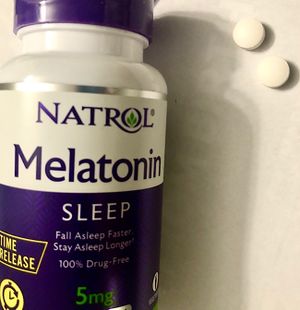Melatonin

Melatonin, also sold under the brand names Circadin Adaflex, Ceyesto, Syncrodin and Slenyto, is a hormone produced in the pineal gland which regulates sleep and wakefulness.[1][2] It is involved in the synchronization of circadian rhythms, including sleep-wake timing, blood pressure and body temperature regulation, cardiovascular efficiency and muscle strength, and many others.[3][4]
Theory[edit | edit source]
Many of melatonin's biological effects are produced through activation of melatonin receptors,[5] while others are due to its role as an antioxidant,[1] with a particular role in the protection of nuclear and mitochondrial DNA.[6]
Melatonin over-the-counter supplements or medication are commonly used for helping people get to sleep or stay asleep.[7][2]
ME/CFS[edit | edit source]
Evidence[edit | edit source]
As a medicine, it is used for the treatment of insomnia, however, scientific evidence is insufficient to demonstrate a benefit in this area.[8] Melatonin is also used for sleep dysfunction.
As a medicine, some forms of melatonin are licensed for use for insomnia or sleep in children with ADHD.[2]
Costs and availability[edit | edit source]
In Canada and the United States, melatonin is sold over-the-counter. In other countries, such as the United Kingdom, it is only available with a prescription but may be legal to import for personal use.
Dosage[edit | edit source]
Typical doseage for melatonin is 1-5mg per night.[2]
Risks and safety[edit | edit source]
Melatonin should only be used after doctor's advice in people with an [[autoimmune disorder|autoimmune disease],[2] however ME/CFS is not classed as an autoimmune disease at present despite the presence of some immune symptoms.[9][10][11]
Side effects[edit | edit source]
Melatonin side effects are usually mild, these can include:
- Daytime sleepiness/tiredness
- Headaches
- stomach ache
- Nausea
- Dizziness
- Irritability or restlessness
- Dry mouth
- Dry or itchy skin
- Pains in your arms or legs
- Strange or vivid dreams
- Night sweats[12][7]
Notable studies[edit | edit source]
- 1996, Dissociation of body-temperature and melatonin secretion circadian rhythms in patients with chronic fatigue syndrome[13]
- 2016, Effect of melatonin supplementation on plasma lipid hydroperoxides, homocysteine concentration and chronic fatigue syndrome in multiple sclerosis patients treated with interferons-beta and mitoxantrone.[14]
News articles[edit | edit source]
Learn more[edit | edit source]
- Drugs.com - Melatonin
- Wikipedia - Melatonin
References[edit | edit source]
- ↑ 1.0 1.1 Hardeland R (July 2005). "Antioxidative protection by melatonin: multiplicity of mechanisms from radical detoxification to radical avoidance". Endocrine. 27 (2): 119–30. doi:10.1385/ENDO:27:2:119. PMID 16217125.
- ↑ 2.0 2.1 2.2 2.3 2.4 "Slenyto 5 mg prolonged-release tablets". electronic medicines compendium. Retrieved March 4, 2021.
- ↑ Altun A, Ugur-Altun B (May 2007). "Melatonin: therapeutic and clinical utilization". Int. J. Clin. Pract. 61 (5): 835–45. doi:10.1111/j.1742-1241.2006.01191.x. PMID 17298593.
- ↑ Hardeland R, Pandi-Perumal SR, Cardinali DP (March 2006). "Melatonin". The International Journal of Biochemistry & Cell Biology. 38 (3): 313–6. doi:10.1016/j.biocel.2005.08.020. PMID 16219483.
- ↑ Boutin JA, Audinot V, Ferry G, Delagrange P (August 2005). "Molecular tools to study melatonin pathways and actions". Trends Pharmacol. Sci. 26 (8): 412–19. doi:10.1016/j.tips.2005.06.006. PMID 15992934.
- ↑ Reiter RJ, Acuña-Castroviejo D, Tan DX, Burkhardt S (June 2001), "Free radical-mediated molecular damage. Mechanisms for the protective actions of melatonin in the central nervous system", Ann. N. Y. Acad. Sci., 939: 200–15, doi:10.1111/j.1749-6632.2001.tb03627.x, PMID 11462772
- ↑ 7.0 7.1 "Melatonin". drugs.com. Retrieved March 4, 2021.
- ↑ Brasure M, MacDonald R, Fuchs E, Olson CM, Carlyle M, Diem S, Koffel E, Khawaja IS, Ouellette J, Butler M, Kane RL, Wilt TJ (December 2015), Management of Insomnia Disorder [Internet], PMID 26844312
- ↑ Carruthers, BM; van de Sande, MI; De Meirleir, KL; Klimas, NG; Broderick, G; Mitchell, T; Staines, D; Powles, ACP; Speight, N; Vallings, R; Bateman, L; Bell, DS; Carlo-Stella, N; Chia, J; Darragh, A; Gerken, A; Jo, D; Lewis, DP; Light, AR; Light, KC; Marshall-Gradisnik, S; McLaren-Howard, J; Mena, I; Miwa, K; Murovska, M; Stevens, SR (2012). "Myalgic encephalomyelitis: Adult & Paediatric: International Consensus Primer for Medical Practitioners" (PDF). ISBN 978-0-9739335-3-6. Cite journal requires
|journal=(help) - ↑ World Health Organization (2020). "ICD-11 - Mortality and Morbidity Statistics". icd.who.int. Retrieved May 20, 2020.
Diseases of the nervous system
- ↑ "IOM 2015 Diagnostic Criteria | Myalgic Encephalomyelitis/Chronic Fatigue Syndrome". Centers for Disease Control and Prevention. January 27, 2021. Retrieved February 25, 2021.
- ↑ "Side effects of melatonin". NHS. Retrieved December 31, 2023.
- ↑ Williams, G.; Pirmohamed, J.; Minors, D.; Waterhouse, J.; Buchan, I.; Arendt, J.; Edwards, R.H. (July 1996). "Dissociation of body-temperature and melatonin secretion circadian rhythms in patients with chronic fatigue syndrome". Clinical Physiology (Oxford, England). 16 (4): 327–337. ISSN 0144-5979. PMID 8842569.
- ↑ Adamczyk-Sowa, M.; Sowa, P.; Adamczyk, J.; Niedziela, N.; Misiolek, H.; Owczarek, M.; Zwirska-Korczala, K. (April 2016). "Effect of melatonin supplementation on plasma lipid hydroperoxides, homocysteine concentration and chronic fatigue syndrome in multiple sclerosis patients treated with interferons-beta and mitoxantrone". Journal of Physiology and Pharmacology: An Official Journal of the Polish Physiological Society. 67 (2): 235–242. ISSN 1899-1505. PMID 27226183.

